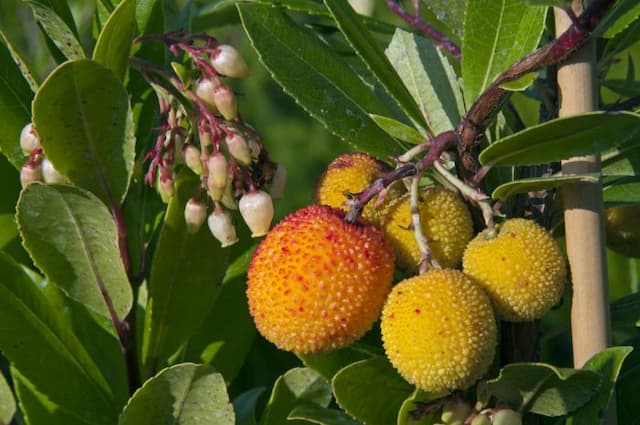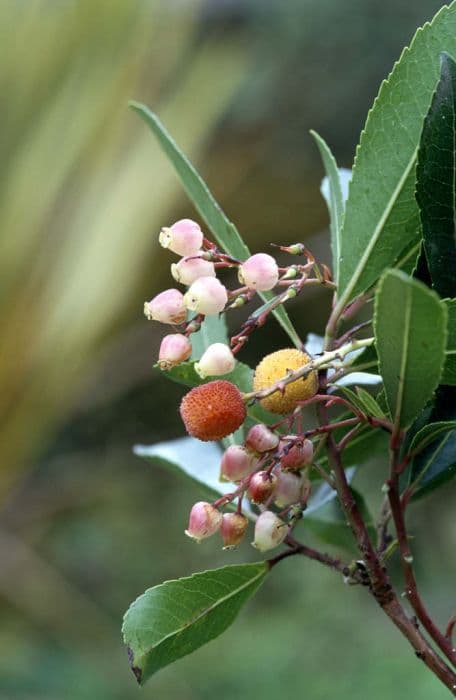Cornish Heath Erica vagans 'Mrs D.f. Maxwell'











ABOUT
Mrs D.F. Maxwell is a variety of Cornish heath which is a charming evergreen shrub known for its decorative appeal. The plant typically displays a dense, bushy habit, showcasing a profusion of needle-like, dark green leaves that provide a rich backdrop throughout the year. It is particularly admired for its beautiful flowers. The blooms can be described as small, bell-shaped, and they are clustered along the upper part of the stems, creating a striking display. The flowers exhibit a captivating deep pink color that can add a lovely splash of brightness to garden spaces. These blossoms are also attractive to bees and other pollinators, adding an element of liveliness as these creatures visit the plant. The overall appearance of Mrs D.F. Maxwell is one of refined beauty, with a lush, textured foliage and a prolific flowering habit that can bring both color and structure to gardens or landscapes where it is planted.
About this plant
 Names
NamesFamily
Ericaceae.
Synonyms
Cornish Heath, Mrs. D.F. Maxwell.
Common names
Erica vagans 'Mrs D.f. Maxwell'.
 Toxicity
ToxicityTo humans
Cornish heath, the common name for Erica vagans 'Mrs D.f. Maxwell', is generally not considered toxic to humans. There are no commonly reported issues associated with the ingestion or contact with this plant among humans. This being said, it's always a good practice to avoid eating or handling unfamiliar plants as some individuals might be sensitive or allergic to certain plant species.
To pets
Cornish heath, which is the most common name for Erica vagans 'Mrs D.f. Maxwell', is also not known to be toxic to pets. It doesn't appear on lists of poisonous plants for animals such as dogs and cats, and there are no widely reported symptoms of poisoning from the ingestion of this plant among pets. However, ingestion of non-food items can sometimes cause gastrointestinal upset in animals, so it is still best to discourage pets from eating plants that are not part of their regular diet.
 Characteristics
CharacteristicsLife cycle
Perennials
Foliage type
Evergreen
Color of leaves
Green
Flower color
Pink
Height
2 feet (0.61 meters)
Spread
2 feet (0.61 meters)
Plant type
Shrub
Hardiness zones
7
Native area
Europe
Benefits
 General Benefits
General Benefits- Attracts Pollinators: Erica vagans 'Mrs D.F. Maxwell' attracts bees and butterflies, contributing to the pollination of your garden.
- Low Maintenance: Once established, it requires minimal care, making it a good choice for gardeners seeking low-maintenance plants.
- Drought Tolerance: It is relatively drought-resistant, making it suitable for gardens in arid climates or for gardeners who prefer water-wise gardening.
- Year-Round Interest: With evergreen foliage and summer flowers, it provides visual interest throughout the year.
- Soil Adaptability: This plant can adapt to a variety of soil types, although it prefers acidic, well-drained soil.
- Erosion Control: Its root system can help stabilize soil on slopes, reducing erosion.
- Wildlife Habitat: It offers shelter and food for wildlife, enhancing the ecological diversity of the area.
- Landscape Design: Its compact size and attractive blooms make it suitable for various landscape designs, including rock gardens and borders.
- Hardy Nature: It is quite hardy and can survive in a range of climates, tolerating cold temperatures well.
 Medical Properties
Medical PropertiesThis plant is not used for medical purposes.
 Air-purifying Qualities
Air-purifying QualitiesThis plant is not specifically known for air purifying qualities.
 Other Uses
Other Uses- Crafting Material: The stems and flowers of Erica vagans can be dried and used to make decorative wreaths or as components in dried flower arrangements.
- Photography Subject: Due to its attractive blooms, this plant is often used by photographers looking for natural subjects for their compositions.
- Educational Tool: The growth pattern and adaptation of Erica vagans can be used to teach students about plant biology and botany.
- Natural Dye: The flowers and leaves may be used to create natural dyes for fabric or paper, although this usage is not commonly documented.
- Garden Design: The plant's growth habit can be utilized to create textural contrasts in garden landscapes or rockeries.
- Ecology Studies: Erica vagans can be used in studies to understand the effects of acidic soils on plant life and biodiversity.
- Beekeeping: Since the flowers attract bees, it can be planted near beehives as a nectar source for honey production.
- Soil Erosion Control: It can be used in certain landscapes to help stabilize soil and prevent erosion due to its mat-forming growth.
- Insectary Plant: It serves as a habitat for beneficial insects, helping to maintain the health of the surrounding ecosystem.
- Artistic Inspiration: The plant's form and flowers can provide inspiration for artists, particularly those who specialize in botanical illustration.
Interesting Facts
 Feng Shui
Feng ShuiThe Heather is not used in Feng Shui practice.
 Zodiac Sign Compitability
Zodiac Sign CompitabilityThe Heather is not used in astrology practice.
 Plant Symbolism
Plant Symbolism- Solitude: The Erica plant, commonly known as heath, often grows in solitary places, symbolizing a preference for seclusion or the enjoyment of one's own company.
- Protection: Heath has been thought to have protective properties, symbolizing safeguarding and shelter, often used in the past to thatch roofs, providing literal protection.
- Good fortune: In some cultures, heather plants, including Erica, are considered lucky, representing an optimistic future and prosperity.
- Admiration: The delicate appearance of its flowers can symbolize admiration for the beauty and strength found in subtlety and modesty.
- New beginnings: Heather blooms in the wild often signal the end of winter and the start of spring, thus they can represent new starts or rejuvenation.
 Water
WaterThe Cornish heath should be watered thoroughly, allowing the water to penetrate deeply into the soil, which encourages deeper root growth. During the growing season, it typically requires watering once a week, with approximately one gallon per plant for established shrubs, depending on weather conditions and soil type. Always check the top few inches of soil for dryness before watering. In hot, dry spells, more frequent watering may be necessary. Ensure good drainage to prevent waterlogging, as the plant does not tolerate standing water.
 Light
LightThe Cornish heath thrives best in full sun to partial shade. To achieve optimal growth and flowering, plant it in a location where it will receive at least four to six hours of direct sunlight daily. It can tolerate some light shade but too much can reduce flowering and cause the plant to become leggy.
 Temperature
TemperatureCornish heath fares well in a range of temperatures, with ideal conditions being between 60 to 70 degrees Fahrenheit. It can withstand minimum temperatures down to 20 degrees Fahrenheit, making it suitable for USDA hardiness zones 6 to 8. Avoid exposing the plant to temperatures above 80 degrees Fahrenheit for prolonged periods, as this may stress the plant.
 Pruning
PruningPrune Cornish heath in late winter or early spring before new growth begins. Pruning is necessary to shape the plant, encourage bushier growth, remove dead or diseased branches, and promote more vibrant flowering. It is typically pruned once a year, but can be done after each flowering period if a more compact shape is desired. The best time for pruning is just after the plant has finished blooming.
 Cleaning
CleaningAs needed
 Soil
SoilCornish Heath (Erica vagans 'Mrs D.F. Maxwell') prefers well-draining, acidic soil with a pH between 4.5 and 5.5. A suitable soil mix can be created using a combination of peat moss, sand, and loamy soil in equal parts to ensure proper drainage and acidity.
 Repotting
RepottingCornish Heath should typically be repotted every two to three years to refresh the soil and accommodate root growth. The best time to repot is in the spring before new growth begins.
 Humidity & Misting
Humidity & MistingCornish Heath thrives best in moderate to high humidity levels. Although it can tolerate lower humidity, it prefers an environment that replicates its natural heathland habitat.
 Suitable locations
Suitable locationsIndoor
Place in bright, indirect light with acidic soil mix.
Outdoor
Full sun to partial shade, well-drained acidic soil.
Hardiness zone
7-9 USDA
 Life cycle
Life cycleCornish Heath 'Mrs. D.F. Maxwell' begins its life cycle when seeds germinate in suitable conditions—lightly acidic, well-drained soil and full sun to partial shade. Seedlings emerge and establish themselves, eventually growing into mature shrubs with needle-like leaves. Throughout the spring and summer, the plants produce profuse pink to purple flowers, attracting pollinators and resulting in the pollination and development of seed capsules. After flowering, the seeds mature and are dispersed, often by wind or wildlife, to start a new generation. In the winter, the plant may experience dormancy but typically remains evergreen if temperatures aren't severe. Over time, these shrubs can form dense mounds and may require some pruning to maintain their shape and encourage new growth.
 Propogation
PropogationPropogation time
Late summer
Propogation: The most popular method of propagating the Cornish heath, whose botanical name is Erica vagans 'Mrs D.f. Maxwell', is through semi-ripe cuttings. This is typically done in late summer. To propagate by this method, a gardener would select a healthy, semi-ripe stem—that is, one that is not too woody but has lost its softest, greenest growth. They would cut a piece about 2 to 4 inches (5 to 10 centimeters) in length, just below a leaf node. Leaves on the lower half of the cutting are removed, and the bottom end is dipped into rooting hormone to encourage root growth. The cutting is then placed in a pot filled with a mix of peat and perlite or a similar free-draining propagation medium. It is essential to maintain high humidity around the cutting, often achieved by placing a plastic bag or a propagator lid over the pot, and keeping the medium moist but not waterlogged. With proper care, the cutting should root in several weeks.









